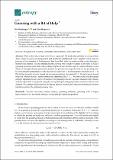| dc.contributor.author | Weinberger, Nir | |
| dc.contributor.author | Shayevitz, Ofer | |
| dc.date.accessioned | 2020-04-27T17:27:46Z | |
| dc.date.available | 2020-04-27T17:27:46Z | |
| dc.date.issued | 2019-12 | |
| dc.date.submitted | 2019-08 | |
| dc.identifier.issn | 1099-4300 | |
| dc.identifier.uri | https://hdl.handle.net/1721.1/124883 | |
| dc.description.abstract | What is the value of just a few bits to a guesser? We study this problem in a setup where Alice wishes to guess an independent and identically distributed (i.i.d.) random vector and can procure a fixed number of k information bits from Bob, who has observed this vector through a memoryless channel. We are interested in the guessing ratio, which we define as the ratio of Alice’s guessing-moments with and without observing Bob’s bits. For the case of a uniform binary vector observed through a binary symmetric channel, we provide two upper bounds on the guessing ratio by analyzing the performance of the dictator (for general k≥1 ) and majority functions (for k=1 ). We further provide a lower bound via maximum entropy (for general k≥1 ) and a lower bound based on Fourier-analytic/hypercontractivity arguments (for k=1 ). We then extend our maximum entropy argument to give a lower bound on the guessing ratio for a general channel with a binary uniform input that is expressed using the strong data-processing inequality constant of the reverse channel. We compute this bound for the binary erasure channel and conjecture that greedy dictator functions achieve the optimal guessing ratio. ©2019 | en_US |
| dc.publisher | MDPI | en_US |
| dc.relation.isversionof | 10.3390/e22010039 | en_US |
| dc.rights | Creative Commons Attribution 4.0 International license | en_US |
| dc.rights.uri | https://creativecommons.org/licenses/by/4.0/ | en_US |
| dc.source | MDPI | en_US |
| dc.title | Guessing with a bit of help | en_US |
| dc.type | Article | en_US |
| dc.identifier.citation | Weinberger, Nir, and Ofer Shayevitz, "Guessing with a bit of help." Entropy 22, 1 (Dec. 2019): no. 39 doi 10.3390/e22010039 ©2019 Author(s) | en_US |
| dc.contributor.department | Massachusetts Institute of Technology. Laboratory for Information and Decision Systems | en_US |
| dc.contributor.department | Massachusetts Institute of Technology. Institute for Data, Systems, and Society | en_US |
| dc.relation.journal | Entropy | en_US |
| dc.eprint.version | Final published version | en_US |
| dc.type.uri | http://purl.org/eprint/type/JournalArticle | en_US |
| eprint.status | http://purl.org/eprint/status/PeerReviewed | en_US |
| dspace.date.submission | 2020-03-05T14:46:13Z | |
| mit.journal.volume | 22 | en_US |
| mit.journal.issue | 1 | en_US |
| mit.license | PUBLISHER_CC | |
| mit.metadata.status | Complete | |
